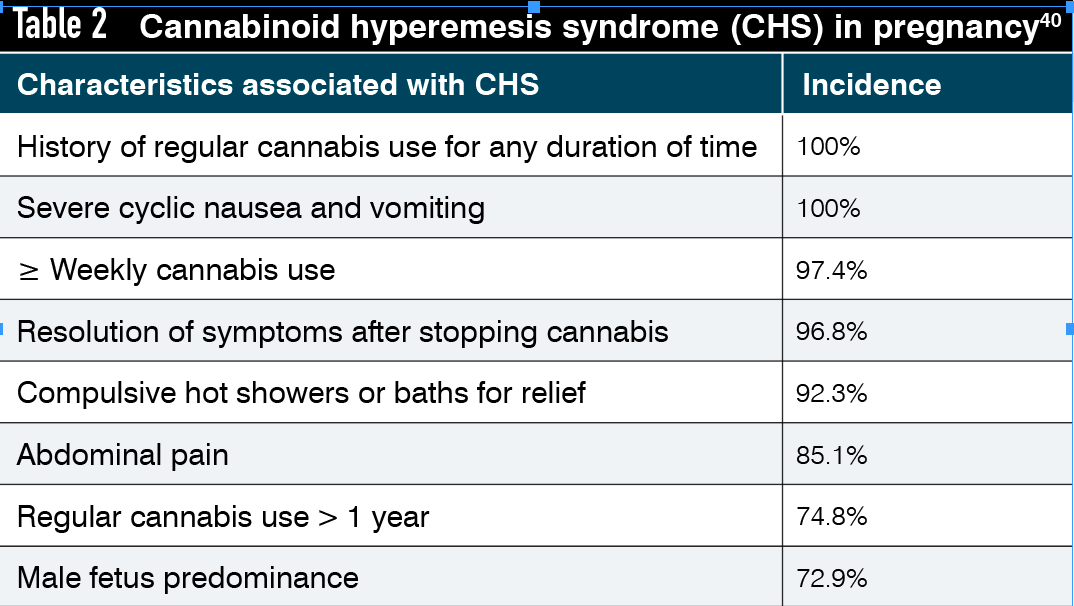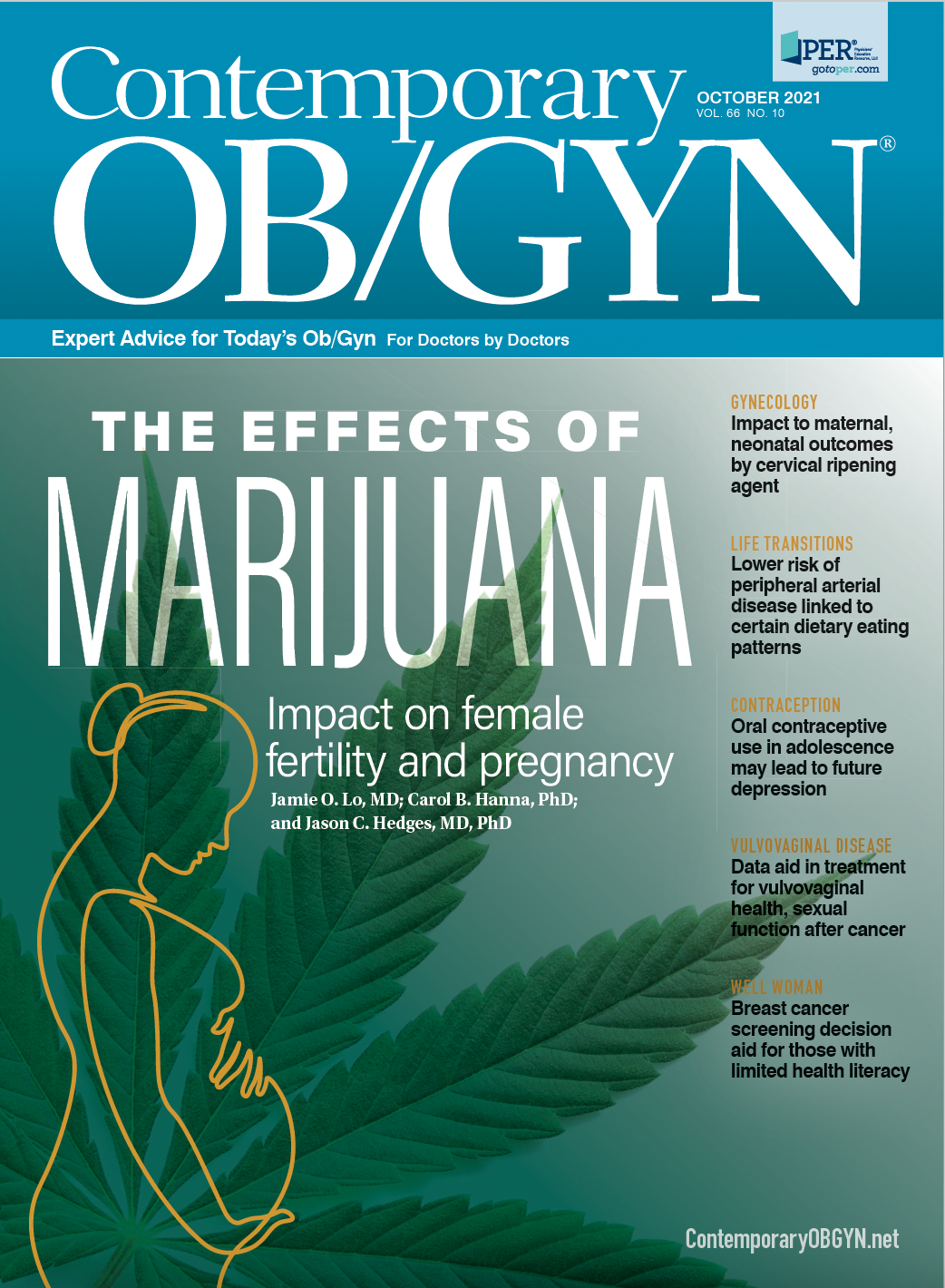View as PDFIntroduction
Marijuana is the most used illicit drug among females of childbearing age and during pregnancy in the United States.1,2 This prevalence is largely secondary to the recent state level legalization of marijuana, resulting in both its availability and perceived safety.
The existing research suggests that marijuana use can adversely affect female reproductive health, and because its main active ingredient, Δ-9-tetrahydrocannabinol (THC), can cross the placenta3,4 and is found in breast milk,5 there also is concern about harm to the developing fetus and offspring.
Public health initiatives have advised those attempting to conceive, those who are pregnant, and lactating patients to abstain from using marijuana. However, because the available safety data and literature are limited, many continue marijuana use during pregnancy.
This is troublesome considering that the potency of marijuana has significantly increased in the past decade.6 The average concentration of THC in products sold in dispensaries can range from 17.7% to 23.2% but can be as high as 75.9%.7
Also, only 17% to 31% of the THC content in products sold through state-licensed and internet dispensaries is accurately labeled.8,9 With growing public endorsement of the potential benefits of marijuana, it is important for health care providers to effectively counsel patients regarding its effects on fertility and future offspring.
MARIJUANA 101
What is marijuana?
Marijuana is from the Cannabis sativa plant, which contains over 600 chemicals and has medicinal and psychoactive properties mediated by compounds called cannabinoids.4 The main psychoactive component is THC, a small, highly lipophilic molecule that is metabolized by the liver with a half-life ranging from 20 to 36 hours in occasional users to 4 to 5 days in heavy users and that can require up to 30 days for complete excretion.4
Common forms and methods of marijuana use
There are different vehicles for marijuana delivery (Table 1). Inhalation is the quickest method for THC to enter systemically, carries less risk of overdosing, and includes smoking, vaporizing, and dabbing. Of these, smoking historically has been the most popular method and provides a rapid onset (1-3 minutes) and short duration (1-3 hours) of symptoms.
Oral absorption includes drops, tinctures, sprays, lollipops, or breath strips and can take approximately 20 minutes before occurrence of symptoms, which can last 1 to 3 hours. In contrast, gastrointestinal absorption includes edibles, candies, drinks, snacks, and capsules that require digestion before feeling an effect, which can occur between 30 and 90 minutes after consumption and last 6 to 8 hours.
Of these, edibles are popular, especially during pregnancy, because they are palatable and discreet and their effects can last for hours. Because of the delay in onset of symptoms, these methods lend themselves to a higher likelihood of overconsumption. There are also other methods such as skin absorption through topicals, transdermals, and suppositories.
EFFECTS OF MARIJUANA USE ON FERTILITY AND REPRODUCTIVE HEALTH
Ovulation and menstrual cyclicity
In general, the literature supports some degree of effect from marijuana use on ovulation and menstrual cyclicity. Preclinical studies have largely shown that acute and chronic exposure to high levels of THC can affect sex hormones (ie, follicle-stimulating hormone, luteinizing hormone), disrupt ovulation, and result in menstrual irregularities including amenorrhea.10-12
However, in females, the literature is less consistent, ranging from no effect or increased cycle length only with frequent marijuana use more than 3 times in the prior 3 months to possibly increased anovulation and suppressed reproductive hormone levels.13,14
Fecundability
Overall, marijuana use has not been demonstrated to significantly affect fecundability. A large prospective observational study that focused on North American couples attempting to conceive found no significant association between female and male marijuana use and fecundability after controlling for confounders.14
Similarly, a retrospective observational study using cross-sectional survey data concluded that marijuana use in any frequency does not prolong the time to conception.15 Most recently, a study (NCT00467363) highlighted the potential risks of preconception marijuana use on fecundability among women with a history of pregnancy loss.16
In vitro fertilization
The literature suggests that preconception use of marijuana negatively affects in vitro fertilization (IVF) success. In females who smoked marijuana within 1 year prior to IVF and gamete intrafallopian transfer, 25% fewer oocytes were retrieved and 28% fewer were fertilized.17
Additionally, in a recent prospective study of females utilizing assisted reproductive technology, those who smoked marijuana at the time of study enrollment had twice the adjusted probability of pregnancy loss as those who were former marijuana smokers or had never used (54% vs 26%; P = .0003).18
USE IN PREGNANCY AND LACTATION
Approximately half of females who use marijuana before conception continue to use throughout pregnancy, especially for its antiemetic properties, particularly in the first trimester during a developmentally vulnerable period.
Most studies report a 2% to 5% prevalence of prenatal marijuana use with up to approximately 30% among young, urban, and socioeconomically disadvantaged females.1,19 They are more likely to be younger, use multiple substances, report nausea and/or vomiting in pregnancy, have other life stressors or mental health conditions, and have limited or disrupted prenatal care.
In pregnancy, patterns of marijuana use reflect smoking as most popular followed by edibles and then vaping, with most using only 1 mode of marijuana delivery.20
The available studies on prenatal marijuana exposure are largely observational or retrospective, confounded by polysubstance use and small sample size and reliant on self-report.19 This is problematic because studies have found that more females are positive for marijuana use by toxicology screen than self-reported use.21
However, the existing evidence supports some degree of adverse outcomes with maternal marijuana use including intrauterine growth restriction, fetal neurodevelopmental consequences, neonatal intensive care unit admission, and impaired cognitive development of offspring.19,22
Recommendations
At present, based on the available evidence, the US surgeon general,23 American College of Obstetricians and Gynecologists (ACOG),4 and the American Academy of Pediatrics24 advise pregnant and lactating patients to abstain from using marijuana. However, all acknowledge that further research is needed to understand all the effects of THC on the developing brain and offspring.4,23,24
Perceived benefits
The most common reason reported for marijuana use in pregnancy involves the perceived benefits, specifically for self-treatment of nausea or hyperemesis. Currently, the effect of marijuana use on nausea and vomiting during pregnancy is unknown. Marijuana also is used during pregnancy for depression, anxiety, sleep, stress, and pain. These are all conditions that have alternative treatments better characterized in the context of pregnancy.
Preterm birth
The existing data are mixed but support an increased risk of preterm birth with marijuana use. A prior systematic review and meta-analysis adjusted for concomitant tobacco use found that only females using marijuana at least weekly in pregnancy had a significantly increased risk for preterm delivery, but not in those using less than weekly.25
This association was not seen when only using pooled adjusted estimates from individual studies that had adjusted for confounders. More recently, a large population-based retrospective cohort study (N= 661,617) in Ontario, Canada, noted an increased risk of preterm birth associated with maternal marijuana use (RR 1.41; 95% CI, 1.36-1.47).26
Fetal growth restriction and low birth weight
One of the most studied topics is the association between prenatal marijuana exposure and fetal growth restriction or low birth weight. There have been multiple systematic reviews, meta-analyses, and retrospective and prospective studies on this subject that suggest there is an association ranging from an 84-gram to 256-gram difference.19,25,27,28
However, a portion of studies did not adjust for confounders like nicotine use. A more recent, large systematic review reported a significantly increased risk of low birth weight was observed in females who used marijuana more than weekly after adjusting for cigarette smoking, but this trend was not seen when only estimates from individual studies that adjusted for all confounders were used.25
Fetal structural anomalies
There are studies addressing the role of marijuana and its association with structural fetal anatomic defects.27,29-33 Anomalies previously described involve the cardiac, genitourinary, gastrointestinal, and central nervous system in addition to craniofacial defects such as cleft lip and/or palate.29-31,33 Most commonly reported were cardiac abnormalities, specifically ventricular septal defects.31,33
However, overall most studies did not consistently find a positive association between periconceptional marijuana use and congenital abnormalities.27,32
Pregnancy loss
The available literature does not appear to support any significant association between prenatal marijuana use and an increased risk of miscarriage or stillbirth.16,19,34 However, the literature is variable, in part because studies reporting an association are confounded by polysubstance use, especially tobacco, or are too small to detect a true relationship.
A recent study (NCT00467363) of females with a history of a prior first-trimester loss found no correlation between preconception marijuana use and miscarriage.16 A previous study focused on the impact of illicit drug use and smoking on stillbirth did detect a significant association between marijuana use and stillbirth but this effect was diminished after adjusting for tobacco use.34
Other complications
Regarding other obstetric complications, there have been no associations found between in utero exposure to cannabis and fetal distress, maternal diabetes, rupture of membranes, abruption, hypertension, maternal weight gain, hemorrhage, or duration of maternal hospital stay.19,27
Offspring neurodevelopment and behavioral outcomes
Currently, the literature does not strongly support an association between prenatal marijuana exposure and longer-term offspring outcomes such as sudden infant death syndrome, cognition, or academic achievement.19
Existing studies have described an effect on offspring neurological development from prenatal or postnatal marijuana exposure including trembling and a high-pitched cry in babies, decreased fine motor skills and abnormal social behavior in infants, decreased problem-solving skills and memory, symptoms of depression and anxiety, decreased attention span in school-aged children, and a predisposition toward delinquent behavior and vulnerability to drug addiction, including marijuana.19,27
Most recently, a large retrospective Canadian study found a significant association between maternal marijuana use in pregnancy and the incidence of autism spectrum disorder (ASD) in the offspring.22 The rate of ASD diagnosis was 2.2% among children with in utero marijuana exposure. The incidence of ASD diagnosis was 4.00 per 1000 person-years (95% CI, 3.65-4.38) among children exposed to cannabis compared with 2.42 (95% CI, 2.39-2.44) among unexposed children.22
The incidence of intellectual disability and learning disorders also was higher among offspring by age 10 years who were exposed to marijuana prenatally, although this was less statistically robust likely because of residual confounding not adjusted for.22 The study was unable to examine the association between the amount or timing of THC exposure in pregnancy and observed childhood health outcomes.
Prior human and animal studies have demonstrated that offspring prenatally exposed to THC have an increased risk for later substance use, delinquency of behavior, enhanced heroin-seeking profiles, and altered areas of the brain known to modify behavioral responses to various environmental stimuli associated with reward behaviors.19,35,36
Monitoring during pregnancy
The available evidence suggests a potential harmful effect of prenatal marijuana exposure on offspring, including decreased fetal weight or low birth weight.19,27 Additionally, most studies did not consistently demonstrate an increased risk between periconceptional marijuana use and structural anatomic defects, but both fetal congenital abnormalities and dysmorphic features associated with Fetal Alcohol Syndrome Disorder have been described.27,29-33
Thus, a detailed fetal anatomic survey and serial growth ultrasounds should be considered in pregnancies complicated by maternal marijuana use, especially if maternal pattern of use is chronic and/or heavy.
Breastfeeding
The prevalence of marijuana use among breastfeeding females in states with legalized marijuana is about 5%.5 This is concerning because THC is highly lipid soluble and transferred into breast milk, where it is stored in lipid-filled tissues like the offspring’s brain, which can potentially affect neurodevelopmental processes.
It has been demonstrated that when THC is smoked, levels peak in breast milk 1 hour post inhalation and remain detectable for 6 days after use.5,37 Exclusively breastfed infants ingest a mean of 2.5% of the maternal dose of THC.
Prior studies have demonstrated that at 1 year of age, offspring exposed to marijuana in utero and through breastfeeding had decreased motor development compared with those not exposed.38
Other observations reported in the literature of infants exposed to THC through breast milk include lethargy, less frequent feeding, and shorter feeding times.39 At this time, no studies have adequately addressed the effects of marijuana exposure through breastfeeding on long-term neurodevelopment.
Cannabinoid hyperemesis syndrome
This is a condition that is difficult to diagnose during pregnancy and characterized by paradoxical cyclic vomiting occurring in patients with a history of chronic cannabis use.40 The classic presentation is severe nausea, intractable vomiting, abdominal pain, and abnormal, compulsive bathing behaviors (Table 2).
Additional symptoms include agitation, diaphoresis, tachycardia, postural hypotension, subjective fevers/chills, and weight loss. It is also unresponsive to antiemetics and episodes usually last 24 to 48 hours at a time but will recur if marijuana use is continued. Long-term therapy is marijuana cessation for approximately 2 weeks.40
Methods for testing
Options for maternal testing include serum (detects use in the past 2-3 days), urine (detects the past 2-3 days in occasional users or the past few weeks in chronic users) and hair (detects use up to 90 days prior).
Medications such as nonsteroidal anti-inflammatory drugs or proton-pump inhibitors have been reported to cause false positives on drug screens, and testing can be affected by body mass index, frequency of use, when marijuana was last used, and the delivery vehicle of marijuana used.
Currently, synthetic or designer cannabinoids are not detected by routine urine drug screens.
Neonatal methods for testing include umbilical cord homogenate and meconium. Umbilical cord homogenate is easier to collect than meconium and because THC deposits evenly across the length of the cord, the location of the segment of cord sent is irrelevant.
Meconium may be more sensitive than cord homogenate testing but is only available after approximately 24 weeks’ gestation, usually passed within 48 hours of birth, and often requires coordinated effort for collection.
SUMMARY
The landscape of marijuana use is continuing to shift, and health care providers need to be adaptable in the approach taken to patients who use marijuana who are attempting to conceive, are pregnant, or are lactating.
Takeaways
- The prevalence of marijuana use in females of reproductive age, as well as the potency of THC in available products, is on the rise and there is sufficient evidence to recommend abstinence for those trying to conceive, are pregnant, or are breastfeeding.
- Marijuana use can affect fertility by adversely affecting sex hormones, ovulation, and menstrual cyclicity.
- There is no significant association between preconception marijuana use or use during pregnancy and miscarriage or stillbirth.
- Prenatal marijuana use is associated with fetal growth restriction, low birth weight, preterm birth, and neonatal intensive care unit admissions.
- Marijuana use during pregnancy is not significantly associated with birth defects.
- Exposure to marijuana during pregnancy and through breastfeeding can be associated with impaired cognitive development of offspring.
As legalization increases, the perception of safety will continue to be promoted. This is concerning because the potency of marijuana is still rising, which means that our limited current understanding of the risks of marijuana use will soon be outdated.
There is now sufficient evidence of harm to warrant avoiding use when attempting to conceive or when pregnant or lactating. ACOG recommends that health care providers universally screen all patients before conception and in early pregnancy regarding marijuana and drug use (Figure), facilitate access to accurate information, provide counseling, and make referrals for treatment.4
References
- Center for Behavioral Health Statistics and Quality. 2019 National Survey on Drug Use and Health: methodological summary and definitions. Substance Abuse and Mental Health Services Administration; 2020. Accessed September 2, 2021 https://www.samhsa.gov/data/report/2019-methodological-summary-and-definitions
- Martin CE, Longinaker N, Mark K, Chisolm MS, Terplan M. Recent trends in treatment admissions for marijuana use during pregnancy. J Addict Med. 2015;9(2):99-104. doi:10.1097/ADM.0000000000000095
- Richardson KA, Hester AK, McLemore GL. Prenatal cannabis exposure – the “first hit” to the endocannabinoid system. Neurotoxicol Teratol. 2016;58:5-14. doi:10.1016/j.ntt.2016.08.003
- Committee opinion no. 722: marijuana use during pregnancy and lactation. Obstet Gynecol. 2017;130(4):e205-e209. doi:10.1097/AOG.0000000000002354
- Bertrand KA, Hanan NJ, Honerkamp-Smith G, Best BM, Chambers CD. Marijuana use by breastfeeding mothers and cannabinoid concentrations in breast milk. Pediatrics. 2018;142(3):e20181076. doi:10.1542/peds.2018-1076
- ElSohly MA, Chandra S, Radwan M, Majumdar CG, Church JC. A comprehensive review of cannabis potency in the United States in the last decade. Biol Psychiatry Cogn Neurosci Neuroimaging. 2021;6(6):603-606. doi:10.1016/j.bpsc.2020.12.016
- Alzghari SK, Fung V, Rickner SS, Chacko L, Fleming SW. To dab or not to dab: rising concerns regarding the toxicity of cannabis concentrates. Cureus. 2017;9(9):e1676. doi:10.7759/cureus.1676
- Vandrey R, Raber JC, Raber ME, Douglass B, Miller C, Bonn-Miller MO. Cannabinoid dose and label accuracy in edible medical cannabis products. JAMA. 2015;313(24):2491-2493. doi:10.1001/jama/2015.6613
- Bonn-Miller MO, Loflin MJE, Thomas BF, Marcu JP, Hyke T, Vandrey R. Labeling accuracy of cannabidiol extracts sold online. JAMA. 2017;318(17):1708-1709. doi:10.1001/jama.2017.11909
- Ryan KS, Mahalingaiah S, Campbell LR, et al. The effects of delta-9-tetrahydrocannabinol exposure on female menstrual cyclicity and reproductive health in rhesus macaques. Fertil Steril Science. 2021;2(3):287-294. doi:10.1016/j.xfss.2021.05.001
- Ayalon D, Nir I, Cordova T, et al. Acute effect of delta1-tetrahydrocannabinol on hypothalamo-pituitary-ovarian axis in the rat. Neuroendocrinology. 1977;23(1):31-42. doi:10.1159/000122652
- Asch RH, Smith CG, Siler-Khodr TM, Pauerstein CJ. Effects of delta 9-tetrahydrocannabinol during the follicular phase of the rhesus monkey (Macaca mulatta). J Clin Endocrinol Metab. 1981;52(1):50-55. doi:10.1210/jcem-52-1-50
- Brents LK. Marijuana, the endocannabinoid system and the female reproductive system. Yale J Biol Med. 2016;89(2):175-191.
- Wise LA, Wesselink AK, Hatch EE, et al. Marijuana use and fecundability in a North American preconception cohort study. J Epidemiol Community Health. 2018;72(3):208-215. doi:10.1136/jech-2017-209755
- Kasman AM, Thoma ME, McLain AC, Eisenberg ML. Association between use of marijuana and time to pregnancy in men and women: findings from the National Survey of Family Growth. Fertil Steril. 2018;109(5):866-871. doi:10.1016/j.fertnstert.2018.01.015
- Mumford SL, Flannagan KS, Radoc JG, et al. Cannabis use while trying to conceive: a prospective cohort study evaluating associations with fecundability, live birth and pregnancy loss. Hum Reprod. 2021;36(5):1405-1415. doi:10.1093/humrep/deaa355
- Klonoff-Cohen HS, Natarajan L, Chen RV. A prospective study of the effects of female and male marijuana use on in vitro fertilization (IVF) and gamete intrafallopian transfer (GIFT) outcomes. Am J Obstet Gynecol. 2006;194(2):369-376. doi:10.1016/j.ajog.2005.08.020
- Nassan FL, Arvizu M, Minguez-Alarcon L, et al; EARTH Study Team. Marijuana smoking and markers of testicular function among men from a fertility center. Hum Reprod. 2019;34(4):715-723. doi:10.1093/humrep/dez002
- National Academies of Sciences, Engineering, and Medicine; Health and Medicine Division; Board on Population Health and Public Health Practice; Committee on the Health Effects of Marijuana: An Evidence Review and Research Agenda. The health effects of cannabis and cannabinoids: the current state of evidence and recommendations for research. 2017. Accessed September 2, 2021 https://www.ncbi.nlm.nih.gov/books/NBK423845/
- Young-Wolff KC, Adams SR, Wi S, Weisner C, Conway A. Routes of cannabis administration among females in the year before and during pregnancy: results from a pilot project. Addict Behav. 2020;100:106125. doi:10.1016/j.addbeh.2019.106125
- Young-Wolff KC, Tucker LY, Alexeeff S, et al. Trends in self-reported and biochemically tested marijuana use among pregnant females in California from 2009-2016. JAMA. 2017;318(24):2490-2491. doi:10.1001/jama/2017.17225
- Corsi DJ, Donelle J, Sucha E, et al. Maternal cannabis use in pregnancy and child neurodevelopmental outcomes. Nat Med. 2020;26(10):1536-1540.
doi:10.1038/s41591-020-1002-5 - U.S. Surgeon General’s advisory: marijuana use and the developing brain. Updated August 29, 2019. Accessed May 26, 2021. https://www.hhs.gov/surgeongeneral/reports-and-publications/addiction-and-substance-misuse/advisory-on-marijuana-use-and-developing-brain/index.html
- Ryan SA, Ammerman SD, O’Connor ME; COMMITTEE ON SUBSTANCE USE AND PREVENTION; SECTION ON BREASTFEEDING. Marijuana use during pregnancy and breastfeeding: implications for neonatal and childhood outcomes. Pediatrics. 2018;142(3):e20181889. doi:10.1542/peds.2018-1889
- Conner SN, Bedell V, Lipsey K, Macones GA, Cahill AG, Tuuli MG. Maternal marijuana use and adverse neonatal outcomes: a systematic review and meta-analysis. Obstet Gynecol. 2016;128(4):713-723. doi:10.1097/AOG.0000000000001649
- Corsi DJ, Walsh L, Weiss D, et al. Association between self-reported prenatal cannabis use and maternal, perinatal, and neonatal outcomes. JAMA. 2019;322(2):145-152. doi:10.1001/jama.2019.8734
- Gunn JKL, Rosales CB, Center KE, et al. Prenatal exposure to cannabis and maternal and child health outcomes: a systematic review and meta-analysis. BMJ Open. 2016;6(4):e009986. doi:10.1136/bmjopen-2015-009986
- El Marroun H, Tiemeier H, Steegers EAP, et al. Intrauterine cannabis exposure affects fetal growth trajectories: the Generation R Study. J Am Acad Child Adolesc Psychiatry. 2009;48(12):1173-1181. doi:10.1097/CHI.0b013e3181bfa8ee
- Shaw GM, Velie EM, Morland KB. Parental recreational drug use and risk for neural tube defects. Am J Epidemiol. 1996;144(12):1155-1160. doi:10.1093/oxfordjournals.aje.a008894
- van Gelder MMHJ, Donders ART, Devine O, Roeleveld N, Reefhuis J; National Birth Defects Prevention Study. Using Bayesian models to assess the effects of under-reporting of cannabis use on the association with birth defects, National Birth Defects Prevention Study, 1997-2005. Paediatr Perinat Epidemiol. 2014;28(5):424-433. doi:10.1111/ppe.12140
- Forrester MB, Merz RD. Risk of selected birth defects with prenatal illicit drug use, Hawaii, 1986-2002. J Toxicol Environ Health A. 2007;70(1):7-18. doi:10.1080/15287390600748799
- Warshak CR, Regan J, Moore B, Magner K, Kritzer S, Van Hook J. Association between marijuana use and adverse obstetrical and neonatal outcomes. J Perinatol. 2015;35(12):991-995. doi:10.1038/jp.2015.120
- Williams LJ, Correa A, Rasmussen S. Maternal lifestyle factors and risk for ventricular septal defects. Birth Defects Res A Clin Mol Teratol. 2004;70(2):59-64. doi:10.1002/bdra.10145
- Varner MW, Silver RM, Rowland Hogue CJ, et al; Eunice Kennedy Shriver National Institute of Child Health and Human Development Stillbirth Collaborative Research Network. Association between stillbirth and illicit drug use and smoking during pregnancy. Obstet Gynecol. 2014;123(1):113-125. doi:10.1097/AOG.0000000000000052
- Hurd YL, Manzoni OJ, Pletnikov MV, Lee FS, Bhattacharyya S, Melis M. Cannabis and the developing brain: insights into its long-lasting effects. J Neurosci. 2019;39(42):8250-8258. doi:10.1523/JNEUROSCI.1165-19.2019
- Spano MS, Ellgren M, Wang X, Hurd YL. Prenatal cannabis exposure increases heroin seeking with allostatic changes in limbic enkephalin systems in adulthood. Biol Psychiatry. 2007;61(4):554-563. doi:10.1016/biopsych.2006.03.073
- Baker T, Datta P, Rewers-Felkins K, Thompson H, Kallem RR, Hale TW. Transfer of inhaled cannabis into human breast milk. Obstet Gynecol. 2018;131(5):783-788. doi:10.1097/AOG.0000000000002575
- Astley SJ, Little RE. Maternal marijuana use during lactation and infant development at one year. Neurotoxicol Teratol. 1990;12(2):161-168. doi:10.1016/0892-0362(90)90129-z
- Committee on Nutritional Status During Pregnancy and Lactation, Institute of Medicine. Illegal drugs. National Academy Press; 1991. Accessed September 2, 2021. Available from: https://www.ncbi.nlm.nih.gov/books/NBK235593/
- Sorensen CJ, DeSanto K, Borgelt L, Phillips KT, Monte AA. Cannabinoid hyperemesis syndrome: diagnosis, pathophysiology, and treatment—a systematic review. J Med Toxicol. 2017;13(1):71-87. doi:10.1007/s13181-016-0595-z
- Cannabis Clinicians Colorado. Medical marijuana new patient success guide. Accessed June 11, 2021. http://coscc.org/wp-content/uploads/2016/07/CCC-General-CannabisAsMedicine-2017DRAFT.pdf
- Wright TE, Terplan M, Ondersma SJ, et al. The role of screening, brief intervention, and referral to treatment in the perinatal period. Am J Obstet Gynecol. 2016;215(5):539-547. doi:10.1016/j.ajog.2016.06.038







